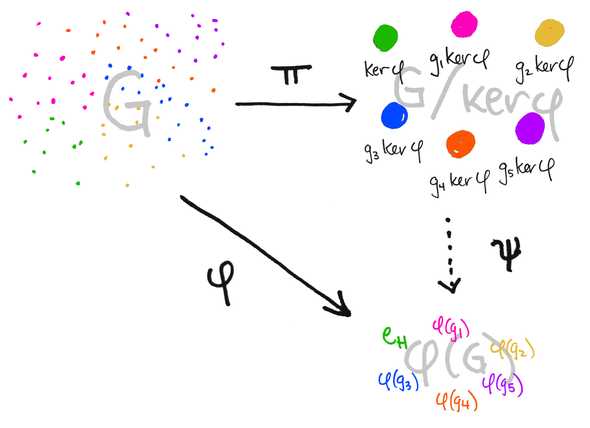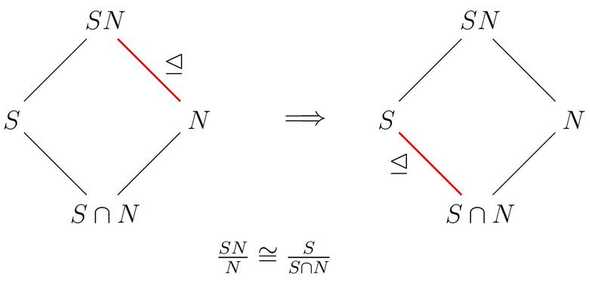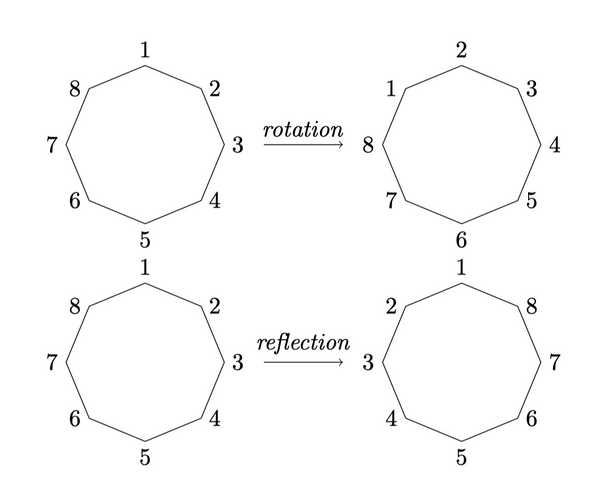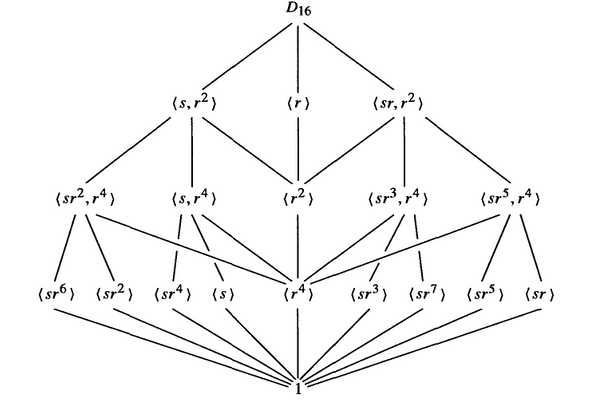Abstract Algebra 02 - The Isomorphism Theorems
January 01, 2021
This is the second post of the Introduction to Abstract Algebra series. In the first post, we introduce the basic concepts of groups. In this post, we will introduce four isomorphism theorems. But first of all, we need to define normal groups.
Normal Groups and Quotient Groups
Recall that we define the cosets as the following: Given a group is a subgroup, for any , a left coset of , and is a right coset. We’ve already shown that all the cosets have the same cardinality (by defining an isomorphism). We’ve also shown that the set of left cosets forms a partition of the group. The idea of quotient groups, denoted as is motivated by the following question: can we define a group based on this set, or can we define a proper binary operation for this set? A perhaps natural binary operation is . This definition is very convenient, as it has the identity , an inverse for each element as , and satisfies associativity. But it has one significant problem: it may not be well defined. You may notice that, a coset can be represented in multiple ways as long as . The question is it true that ? This seems hard to achieve, and indeed this is not true for most subgroups . This is only true if subgroup is normal.
Definition 2.1: Normal Groups
A subgroup of group is a normal subgroup, denoted as , if , , i.e. left & right cosets coincide.
Definition/Lemma 2.2: Quotient Groups
Given a normal subgroup of group , the quotient group, demoted as , is the set of cosets of in , with the binary operation for .
. We show that given , is indeed a well-defined group. For , suppose . First observe that . Since , . Thus . The first equality is due to the normality of .
Definition 2.3: Simple Groups
A group is simple it has no proper normal subgroups.
Note that every group has trivial subgroups: . The idea of normal and quotient groups may be intuitive if we make an analogy to integers. If we consider a group as an integer, then its normal subgroup is its divisor, and the quotient group is its quotient (and hence the name). Following this analogy, simple groups are like the prime numbers. Just like studying prime numbers is important in number theory as they are the building blocks of the number system, simple groups are like building blocks or fundamental structures. If a group is not simple, we can always “factor” it out into its normal and quotient groups, just like prime factorization.
Following this idea, we can always “project” a group to its quotient group via a homomorphism.
Definition/Lemma 2.4: Projection Homomorphism
If , the mapping defined as is a well-defined homomorphism.
. The mapping is well-defined since the set of cosets is a partition of . It is a homomorphism since by the normality of . Also note that the homomorphism is subjective.
Kernel and Image
Now we define the kernel and image of a homomorphism.
Definition 2.5: Kernel and Image
Given a homomorphism ,
- The kernel of is .
- The image of is .
Lemma 2.6: Kernel and Image
- The kernel of any homomorphism is a normal subgroup of .
- The image of any homomorphism is a subgroup of .
. It’s straightforward to check that the kernel and image are indeed subgroups of and by checking the three axioms or showing that they are closed under multiplication and inverses. Checking that the kernel is a normal subgroup is also straightforward but we will lay out the steps. We want to show that for , , or for . We show this by noting that .
Corollary 2.7: Kernel of Homomorphisms from Simple Groups
Given a homomorphism where is a simple group, then , i.e., is trivial or injective.
The First Isomorphism Theorem
Theorem 2.8: The First Isomorphism Theorem
Given a homomorphism , .
. To prove this theorem, all we need to do is to define an isomorphism . The idea is given the homomorphism and the induced projection homomorphism defined in Lemma 2.4 , we define our so that , which will complete the proof. The idea is illustrated in Figure 1.
Figure 1. The First Isomorphism Theorem. (Image source: The First Isomorphism Theorem, Intuitively. Nov. 28, 2016. Algebra, Math3ma.)
Formally, let denote . We define by . Thus, by definition, , so we only need to prove that this is a well-defined homomorphism. First, is well-defined since if , then
.
Second, is a homomorphism since
Thus, we proved that is an isomorphism.
Symmetric Groups and Alternating Groups
Upon introduction of the first isomorphism theorem, it’s convenient to introduce two kinds of very important groups.
Consider a set which contains 3 elements. We can define a bijective map , which is called a permutation. For example, we can send 1 to 2, 2 to 3, 3 to 1. This permutation is denoted as . We can also send 1 to 3 and leave 2 unchanged, and this permutation is denoted as . This “parenthesized” notation is called a cycle decomposition. There are in total permutations. For a set with more elements, the cycle decomposition can be more complex. For example, for a set of elements, a permutation can be . It shouldn’t be too hard to check that a k-cycle has an order . More generally, a (m-cycle)(n-cycle) has an order . We call a 2-cycle a transposition. A cycle decomposition can always be written as composition of transpositions, for example, . In general, a m-cycle is .
Symmetric Groups of elements contains all the permutations permutations on a set of elements.
Definition 2.9: Symmetric Groups
The symmetric group on n letters, , is a group with elements, where the binary operation is the composition of maps.
It should be straightforward to check that this is indeed a group. It is closed by multiplication and inverse since by definition it contains all the permutations.
Definition/Lemma 2.10: Alternating Groups
The alternating group on n letters, , is a subgroup of , where .
. To justify that is indeed a subgroup of , first note that the definition is unambiguous. If two products of transpositions are the same permutation, their length must have the same parity. We can first prove that the identity can only be written as the product of an even number of transpositions by induction on the length of the transpositions. This implies that two equivalent products of transpositions must have the same parity. Secondly, permutations that are products of even number of transpositions are closed under multiplication and inverses.
It may be intuitive that the size of is always . However, this can be hard to prove if we don’t use techniques from group theory. By applying the first isomorphism theorem, we can prove this rather easily. To do this, we need to define another type of groups .
Definition 2.11: Cyclic Groups
For , denotes the set of nth roots of unity, i.e., . The cyclic groups is defined as , where the binary operation is the usual multplication for numbers.
You may wonder why have the same name as the property “cyclic”. Recall that all the cyclic groups of the same order are isomorphic, e.g., , so in fact there are only one type of cyclic groups up to isomorphism. We just choose to use one of them for convenience.
Theorem 2.12:
. To prove this claim, we want to define the subjective homomorphism such that , and then the first isomorphism theorem gives the claim. Recall that $,
We define as . Without a proof, we claim that this is indeed a subjective homomorphism.
Proposition 2.13: Any subgroup of index 2 is normal.
Given a subgroup where , there are only two left cosets: . For a , if , then and ; else if , then since is closed and .
Corollary 2.14:
The Second Isomorphism Theorem
Before introducing the second isomorphism theorem, we need some preparations.
Definition 2.15: Normalizer
Given a group , a subset , the normalizer of in , denoted as , is .
We claim that is a subgroup of , which should be easy to check by applying definitions. Note that is a normal subgroup of . In fact, the definition of can be phrased as the largest subgroup of in which is normal. Note also that a group is normal to iff .
Lemma 2.16: Product of Two Subgroups
Given two subgroups , we define .
- is a subgroup of ;
- ;
- is a subgroup of iff ;
- If , then .
. The first claim can be shown by checking the definitions. The second claim can be proven by the following steps. First, . Second, for ,
so . Third, using the same arguments in the proof of Lagrange’s theorem .
The third claim can be shown by working from both directions, and use/check the axioms of groups. For the fourth claim, for all , . Then .
Theorem 2.17: The Second Isomorphism Theorem
Given two subgroups , then
- is a subgroup of ;
- ;
- ;
- .
Figure 2. illustrated the theorem.
Figure 2. The Second Isomorphism Theorem. (Image source: p Groups. Intuition about the second isomorphism theorem. Apr. 12, 2016. Stackexchange.)
. For the first claim, we’ve already proven it in Lemma 2.16. For the second claim, note that . For the third claim, we’ve already in Lemma 2.16 that , so . The first three claims make sure that the fourth claim is well-defined. To prove the fourth claim, we define the homomorphism by . To complete the proof, check directly that is a well-defined homomorphism, is surjective, and that ; then use the first isomorphism theorem to finish the proof.
The Third Isomorphism Theorem
Given two normal subgroups , then
- ;
- Denote as , and as , .
. The second claim is a bit like canceling out factors when we are working with numbers. To prove the first claim, we directly apply the definition of normality and check. To prove the second claim, we again define a subjective homomorphism and utilize the first isomorphism theorem. We define the homomorphism by . Again, we need to check that 1) is well-defined; 2) is a homomorphism; 3) is subjective; and 4) . The first three items can be shown by checking the definitions and applying the premises.
The Lattice Isomorphism Theorem
Given a normal subgroup , there exists a bijection from the set of subgroups of G that contains to the set of subgroups of . Specifically, for all subgroups such that ,
- iff ;
- If , then ;
- = ;
- iff ;
The bijection is given by some , , i.e. the inverse is the pre-image of .
This theorem is called the lattice isomorphism theorem, since it allows us to “factor” a group into its subgroups, which is the lattice of the group, as the lattice of (dihedral groups which we haven’t defined yet) is illustrated in Figure 4.
Example 2.1: Dihedral groups
Figure 3. The Generators of Dihedral groups
Dihedral groups are subgroups of which consist of the rigid motions (reflections and rotations) of a regular n-sided polygon or n-gon. It should take some pondering, but there are exactly unique motions, further every motion can be generated by the reflection and the rotation. Say the reflection is and the rotations is , then formally,
Figure 4. The Lattice of .
References
[1] Siegel, Kyler. MATH GU4041 Introduction to Modern Algebra I. Department of Mathematics, Columbia University. 2019.
[2] Dummit, David and Foote, Richard. Abstract Algebra. Third Edition. John Wiley and Sons, Inc. 2004.



